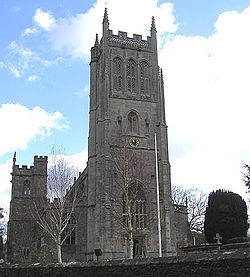Bruton
| Bruton | |
| Somerset | |
|---|---|
 Bruton, from the Dovecote | |
| Location | |
| Grid reference: | ST684350 |
| Location: | 51°6’48"N, 2°27’10"W |
| Data | |
| Population: | 2,945 (est.) |
| Post town: | Bruton |
| Postcode: | BA10 |
| Local Government | |
| Council: | South Somerset |
| Parliamentary constituency: |
Somerton and Frome |
Bruton is a town in Somerset, on the River Brue along the A359 between Frome and Yeovil. It is seven miles south-east of Shepton Mallet, just south of Snakelake Hill and Coombe Hill, ten miles north-west of Gillingham, Dorset and twelve miles south-west of Frome. The parish includes the hamlet of Wyke Champflower.
Bruton station is on the Great Western mainline between Westbury and Taunton.
Bruton has a museum dedicated to the display of items from Bruton's past from the Jurassic geology right up to the present day. The museum houses a table used by the author John Steinbeck to write on during his six-month stay in Bruton.
The River Brue has a long history of flooding in Bruton. In 1768 the river rose very rapidly and destroyed a stone bridge.[1] On the 28 June 1917, 242.8 mm of rain fell in 24 hours at Bruton,[2] leaving a water mark on one pub twenty feet above the normal level of the river.[3] In 1984 a protective dam was built 1 km upstream from the town.[4]
Churches

Both the 14th-century Church of St Mary,[5] and Holy Trinity, in Wyke Champflower,[6] which is dated at 1623, are Grade I listed buildings.
John Wesley preached in Bruton in 1776 and a Methodist chapel at West End was opened in 1848.[7]
History
Bruton was listed in the Domesday Book of 1086 as Briuuetone; the first element is believed to be the Old Welsh for a vigorously flowing river,ref>Robinson, Stephen (1992). Somerset Place Names. Wimborne, Dorset: The Dovecote Press Ltd. ISBN 1-874336-03-2.</ref> which river is now known as the River Brue. The river has been the site of several watermills and in 2003 the South Somerset Hydropower Group installed their first hydroelectric turbine at Gants Mill at nearby Pitcombe.[8][9]
Bruton Abbey was an Augustinian priory from which a wall remains in the Plox close to Bow Bridge. The priory was dissolved at the dissolution of the monasteries and sold to the Berkley family who converted it into a mansion which was demolished in the 18th century.[10]
Bruton is referenced in a well-known English folk song, The Bramble Briar. A very rare copy of an Inspeximus of Magna Carta was discovered in Bruton in the 1950s and claimed by King's School, Bruton. The sale of the school's copy to the Australian National Museum paid for a great deal of the building work at the school.
The Bruton Museum Society was formed in 1989 and involved the community and local schools in the development of the collection of local artefacts. The time spent in the town by John Steinbeck is commemorated in the museum. They have also organised exhibitions at King's School including one in 2008 of the work of Ernst Blensdorf.[11]
In December 2012 plans were announced by Hauser & Wirth to open a new gallery and arts centre at a derelict farm on the outskirts on Bruton.[12]
Outside links
| ("Wikimedia Commons" has material about Bruton) |
- Bruton Parish
- Bruton Hundred
- The Somerset Urban Archaeological Survey: Bruton
References
- ↑ Singh, Vijay P. (15–18 December 2003). Watershed Hydrology: Proceedings of the International Conference on Water and Environment. Bhopal, India: Allied Publishers. pp. 426, 485–488. ISBN 978-81-7764-547-7. http://books.google.ca/books?id=73DdflwDU0oC&pg=PA485.
- ↑ "The Boscastle storm of August 2004 and other heavy rainfall events of the last century in the area". wiseweather.co.uk. http://www.wiseweather.co.uk/id54.html. Retrieved 6 November 2008.
- ↑ Simons, Paul (27 June 2007). "June’s freak downpours have historical precedent". The Times (London). http://www.timesonline.co.uk/tol/news/weather/uk_and_roi/article1991176.ece. Retrieved 6 November 2008.
- ↑ Clark, Colin (2004). "Real-time flood forecasting". International Water Power and Dam Construction website. Progressive Media Markets Ltd. http://www.waterpowermagazine.com/storyprint.asp?sc=2025430. Retrieved 6 November 2008.
- ↑ National Heritage List 1056408: Church of St Mary
- ↑ National Heritage List 1366339: Church of the Holy Trinity
- ↑ [1]
- ↑ Mirage and oasis: Energy choices in an age of global warming, New Economics Foundation, ISBN 1-904882-01-3, published June 2005, accessed 11 June 2007
- ↑ Case Study - Gants Mill, British Hydropower Association, published 2004, accessed (sic) 11 June 2007
- ↑ Adkins, Lesley and Roy (1992). A Field Guide to Somerset Archaeology. Wimborne, Dorset: Dovecote Press. p. 31. ISBN 0-946159-94-7.
- ↑ "BRUTON MUSEUM AT KINGS SCHOOL Blensdorf Retrospective". Galleries UK. http://www.galleries.co.uk/pr/s7-08-BRUTON-MUSEUM-AT-KINGS-SCHOOL-pr1.htm. Retrieved 31 May 2010.
- ↑ Brown, Mark (16 December 2012). "Hauser & Wirth to open new art gallery in Somerset". Guardian. http://www.guardian.co.uk/artanddesign/2012/dec/16/hauser-wirth-art-gallery-somerset. Retrieved December 17, 2012.